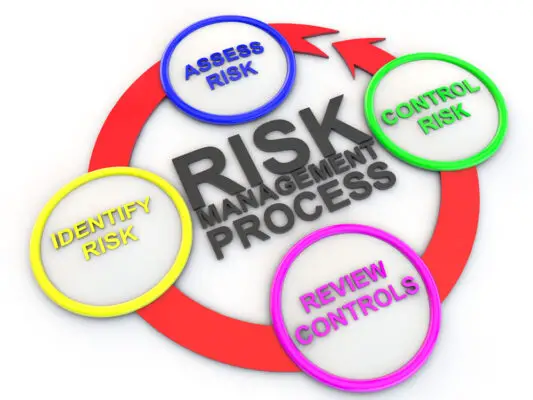Many risk management techniques can help you get a complete view of risk. One is to use scenario analysis, which involves creating different possible scenarios and then assessing the likelihood of each one. Another is to use decision trees, which can help you identify all the possible outcomes of a given decision. And finally, sensitivity analysis can be used to see how sensitive your results are to changes in assumptions.
Unpredictable threats can affect any company and can have devastating consequences in their own way. Businesses may wish to avoid each type of risk, from financial and operational risks to global security risks. There’s certainly no one right or wrong risk – some are worthy of reward and are crucial to business growth. Following standard processes to identify risk management is helpful.
In the dynamic risk environment of today, implementing risk management practices is essential. McKinsey found that when banks closed branches and corporation offices, it affected customer interactions, forcing a change in the risk management practice. How quickly and efficiently risks are detected is critical to determine a company’s recovery from losses.
Neither multinational companies nor startups are immune from risk. It is an important component of every new project. How can a company minimize its impact by implementing Risk Control Management techniques? We’ll explain visual risk management techniques for your risk management program and how you can use the techniques.
Risk management is one of the most important aspects of the business. Without it, any organization can be brought to its knees by a single unforeseen event. However, risk management isn’t just about averting disaster; it’s also about making informed decisions to help an organization grow and succeed.
In this blog post, we’ll discuss some key risk management techniques you need to know. We’ll also look at how to get a real picture of your risks to make informed decisions about managing them. So, let’s get started!
What is Risk Management?
Risk management is identifying, assessing, and mitigating risks to an organization. It includes proactive and reactive measures and covers all aspects of an organization’s operations. Risk management aims to protect the organization’s assets and reputation.
To achieve this, risk managers must first identify their organization’s risks. They then assess the likelihood and severity of these risks. Finally, they develop plans to mitigate or reduce the impact of these risks.
Risk management is an essential part of any organization’s operation and requires carefully balancing resources and priorities. Organizations can protect themselves from avoidable losses and ensure that their operations run smoothly.
Risk management relates to identifying risks and controlling them effectively. Risk management technology allows businesses to increase success rates by reducing risks and maximizing opportunities. It is critical for businesses to manage risk to avoid financial loss and grow revenues.
Other advantages of managing risk are: the first steps in the risk management process are identifying and analyzing risks and the planning process for minimizing risk.
Why is risk management important?
Project and operating risk are no longer common across most organizations, but risk management tools are essential to identify your business strengths, weaknesses, opportunities, and threats. An organization needs to have an established risk management process, not forgetting how risk management strategy important.
The effectiveness and cost-effectiveness of risk management is also important. Tools with a qualitative risk analysis perspective are good for risk assessment and managing risks.
Customer satisfaction and loyalty
Your brand and online identity will help your clients get noticed daily. Your customers are assured when the risk management plan helps protect your reputation. Your risk strategy can aid you in protecting your brand identity and your business’s assets. The use of different risk management strategies will add diversification to the strategy.
It also gives clients the confidence to provide the services you commit to. This resulted in increased client satisfaction and customer retention.
Protection of your company’s assets
The security and privacy of assets are crucial in every organization. In a new IBM data breach study, the average cost of a huge data breach is approximately $3.86m US per year. 81 percent of all stolen data was customers’ personal information; this includes personal and business information collected by an unauthorized third party.
Hence, developing the right risk management strategy is vital to any business insurance policy.
Realizing benefits and achieving goals
Quality of project completion is critical to meeting the intended goals. Using risk identification and management practices can help you eliminate risks faster. So your anticipated portfolio is able to deliver the desired outcomes as well as the expected business performance.
Operational Effectiveness and Business Continuity
Even if your firm is fully prepared, operational risks can appear in any situation. Some risks could arise from securing your data and information from hackers or cyber-attacks. The fact that all the parts of a business are affected is advisable.
Planning to Avoid Future Risks
During this planning stage in your risk management cycle, you focus on managing the risks and finding solutions. Find the best way to minimize these risks in your project to the best extent possible.
Process Decision Program Chart
PDPC helps you determine if there is something wrong with the current plan. This chart can be used to modify your plans to reduce potential problems and develop a contingency plan to reduce the potential for a catastrophe.
How do I use this tool? Create a tree diagram of a project identifying objectives, principal activities, and the tasks required for each project. Step 2: Take the task to the third level and think about what could fail. Step 3: Ensure that the problems identified earlier do not impact others. Adds corresponding significant issues to every task in the tree diagram.

Risk Management Strategy Definition
Whenever a business is successful, it should implement a risk management strategy in the form of risk management. Instead of focusing the risk management program on discretized tasks, it would have been better to view the strategy as one which iteratively requires continuous analysis and monitoring.
This allows continuous assessments and responses, which ensure the safest use of personnel, assets, and resources. Depending on how you manage risk, there are four possible choices to manage risks.
Identifying risks
Risk Identification occurs through passively looking at vulnerabilities or implementation of control mechanisms, raising red flags when potential risk identified exists. Being proactive instead of reactive can help minimize risk points.
Assessing Risks
After a potential risk is identified, each risk should be assessed to establish its likelihood, severity, and potential impacts. Your Audit Team should conduct a risk assessment for Sarbanes Oxley (SOX). The number of risks evaluated varies by business size.
Responding to Risks
Evaluating risk, the next step in the process involves developing and implementing treatment and controls. This ensures the organization addresses all risks accurately and effectively promptly.
Monitoring risks
Risk monitoring is an ongoing process that identifies and controls new risks by analyzing risk management executions. Monitoring risk provides prompt action if risk is more serious and has greater potential impacts.
Who is responsible for developing a risk management strategy?
Identifying, assessing and developing the best risk management strategies will vary depending on the complexity and scope of the business. How should we approach risk management and improvement?
It could fall under the responsibility of risk managers, e.g. audit team members, project managers, risk professionals, etc. In selecting which route to follow, you must consider many factors.

Identify threats
When managing risk, it’s important to identify the risks you are exposed to. The complexity of risk changes continuously; therefore, it is important to be aware of emerging trends in this sector. Many resources are available to keep ahead of the competition and reduce your risk.
Some examples are just reading trade publications, participating in trade conferences, attending trade prevention forums, and receiving case study examples. Often, these reports are industry-specific and can also help identify potential security risks.
Transfer the risk
Businesses can transfer risks to other parties, usually through insurance policies. You can also transfer risk through hedger strategies, futures trading, and derivative products. You may pool the risk if a group decides it is worth sharing with its members.
Whenever a member of the Group suffers death or injury, everyone contributes to the compensation as usual for traditional insurance. It has benefits: you can share some or largely all risks with a third party.
Avoid the risks
There’s some downside. In some instances, securing specific trades or business acquirements is not risky or necessary. The risk of failure should be removed or stopped if the risk has become too high and the risks are too bad to move on.
This method is the most efficient way to prevent risks. Eliminate the risk of loss and eliminate threats completely. This method should be used only if you have exhausted all other strategies and find it to be dangerously expensive.
Accept the risk
It might seem best when a threat is slightly more serious than a large risk. You can mitigate this by using easy, inexpensive alternatives that will help you avoid the problem. Or just go with the normal routine.
Risk management has a huge benefit in that it isn’t invasive, and you don’t have to invest in fewer threats or opportunities. Keep an eye out for small hazards to avoid unpleasant surprises.
Identify the impact of threats
Then it is necessary to analyze how threats can impact your company using a risk matrix. To achieve this, you should evaluate all the threat’s potential likelihood based on the severity of its consequences.
Identifying the impact of this can assist you in establishing an optimum risk-management strategy. There are three ways to classify threats according to the highest or technical impact.
Identify Probability of Threat Occurrence
Whenever we evaluate an individual threat, there must be two variables: likelihood and outcome. Probability is the probability that a particular risk event will be detected.
The outcome determines the resulting consequences. Any threat can be rated based on its unique combination of the probability of the event and outcome.
Assess the risks
Risk assessments are a process that identifies and measures future event effects. Risk assessment is divided into three main tasks: identifying threats, assessing their impact, or calculating the potential for their occurrence.
Manage risk
Once you have identified a potential threat and its potential impact, you can begin your work on managing it. In general, you may need to select one bucket for managing a particular risk.
Analyze the identified risks
Once the risk is found, you will assess it and see how it affects the businesses they run. The correct risk analysis can help prioritize the risks that affect business operations.
Fault tree analysis
The researchers use fault trees to determine the probability that different outcomes will occur from a set of faults or failed attempts. It analyzes faults by visualizing certain situations at the top and the conditions causing those events.
Describe the problem or error that must be evaluated. Step 2: Show all the immediate or direct causes. Ensure that the causes of the defects are investigated. Step 3: When applying data to a fault tree, use this to evaluate a fault.
Conclusion
Risk management is the process of identifying, assessing, and managing risks. Many different risk management techniques can be used to get a more accurate picture of the risks in a given situation. Some of these techniques include:
- Probability and Impact Analysis: This technique involves estimating the probability of an incident occurring and the impact that it would have if it did occur. This information can be used to prioritize risks and determine which ones need to be addressed first.
- Scenario Analysis: This technique involves imagining different possible scenarios and estimating the risks associated with each scenario. This can help identify potential risk hotspots and help plan for potential emergencies.
- Risk Rating: This technique involves rating risks on a scale from 1 to 10, with 1 being the lowest and 10 being the highest. This can help prioritize risks and focus resources on the highest-risk situations.
Through understanding and using these risk management techniques, you can get a more accurate picture of the risks that are present in your business. This information can help you make better decisions about addressing those risks and keeping your business safe. Have you tried any of these techniques? What has been your experience? Let us know in the comments.

Chris Ekai is a Risk Management expert with over 10 years of experience in the field. He has a Master’s(MSc) degree in Risk Management from University of Portsmouth and is a CPA and Finance professional. He currently works as a Content Manager at Risk Publishing, writing about Enterprise Risk Management, Business Continuity Management and Project Management.

